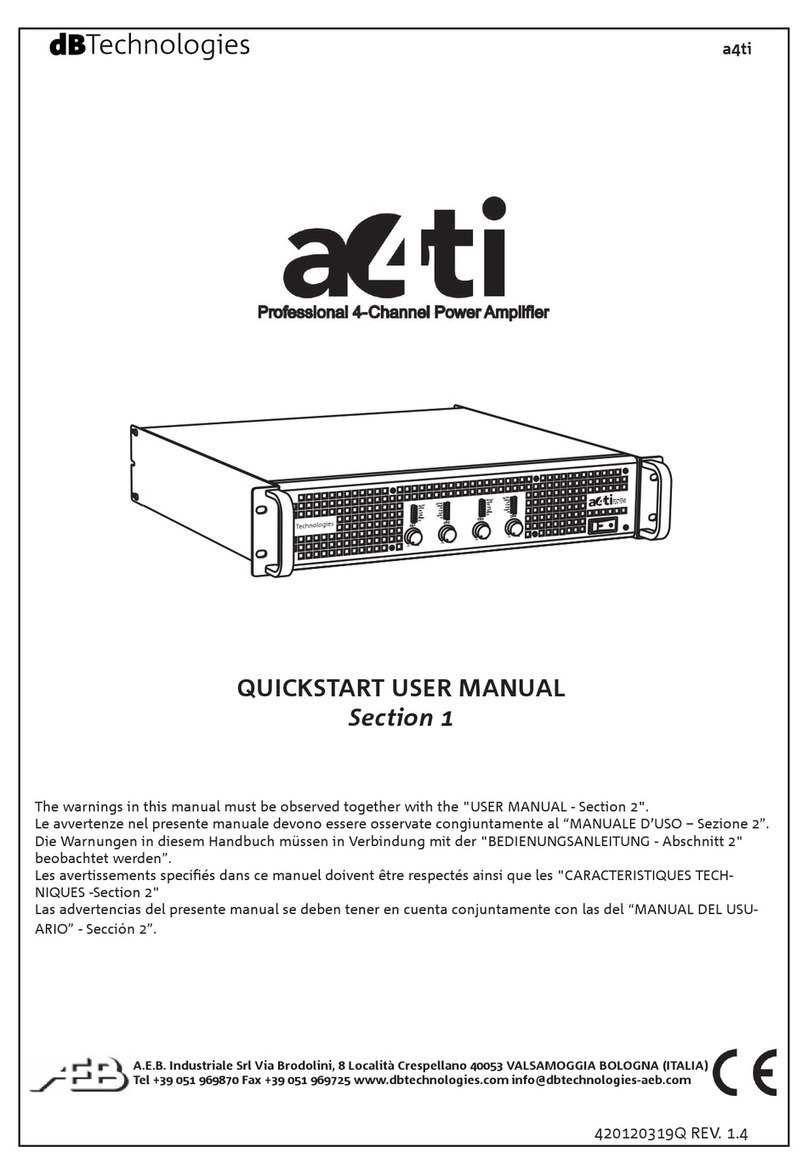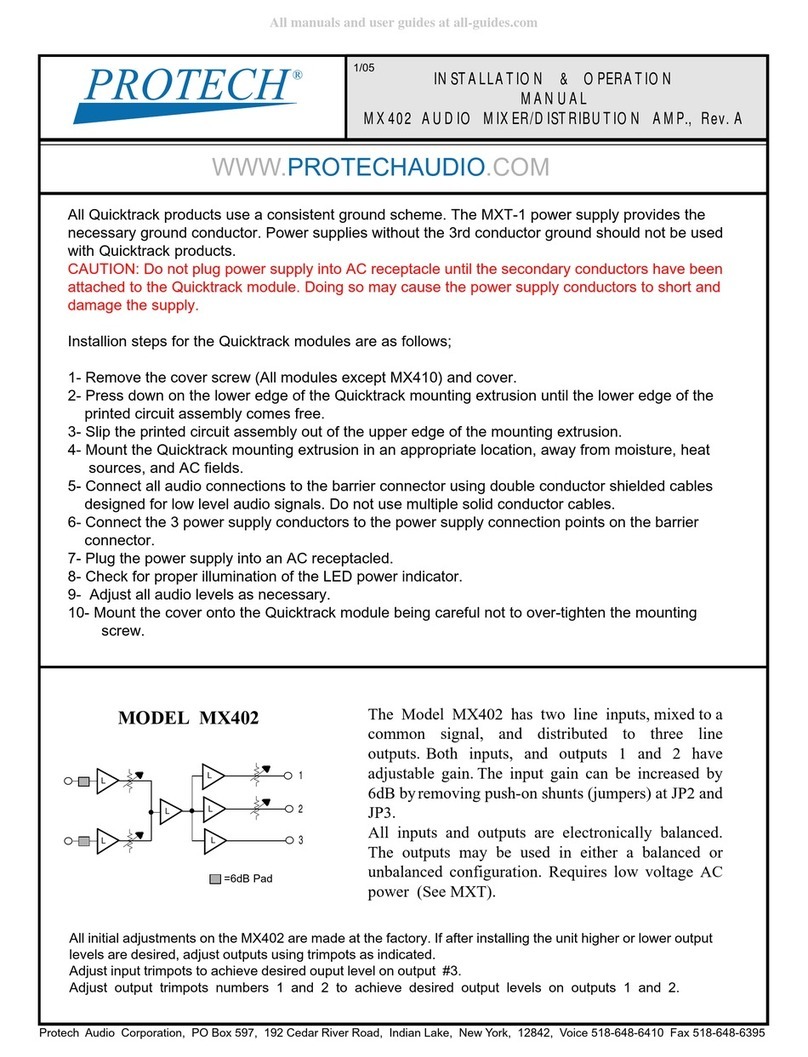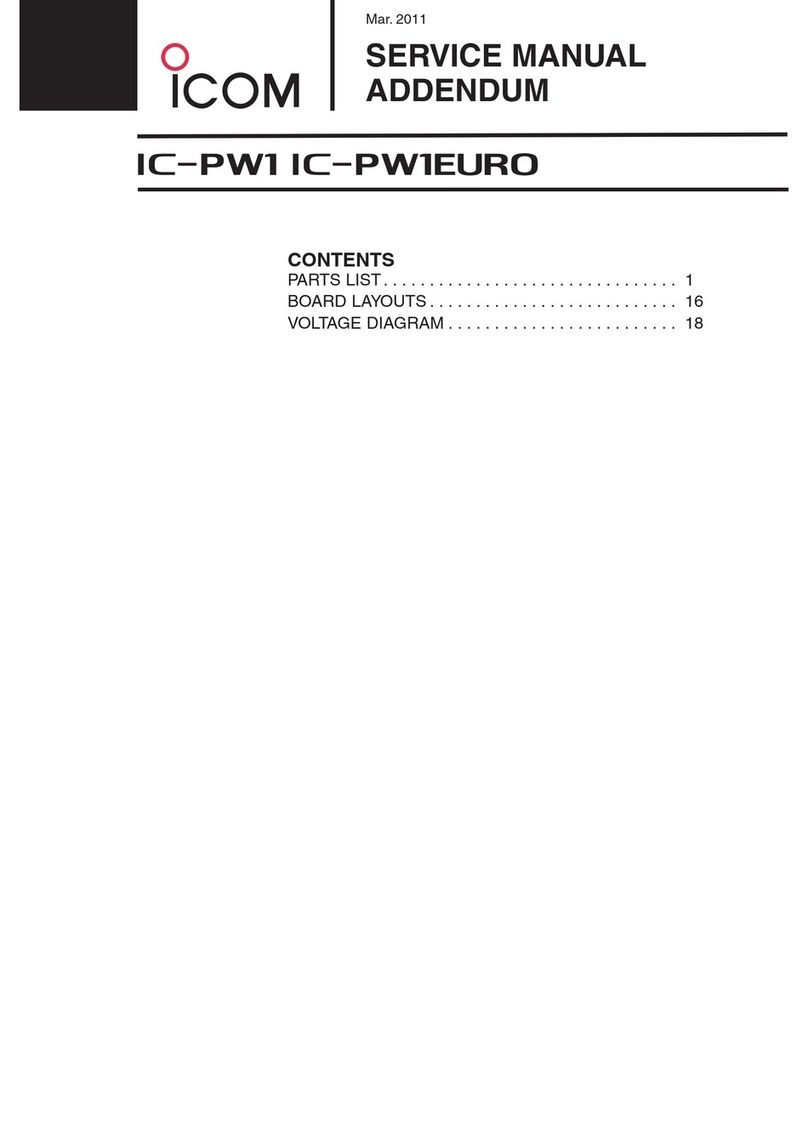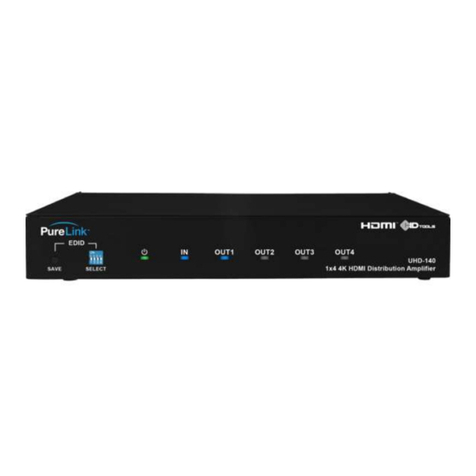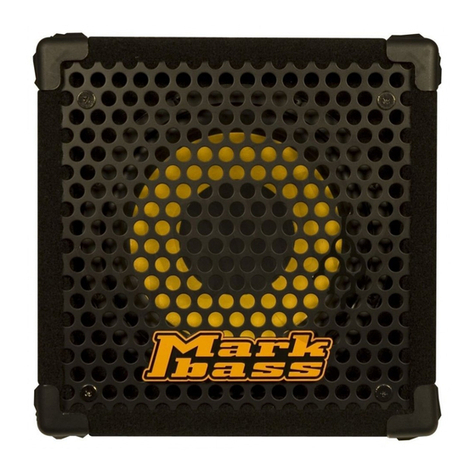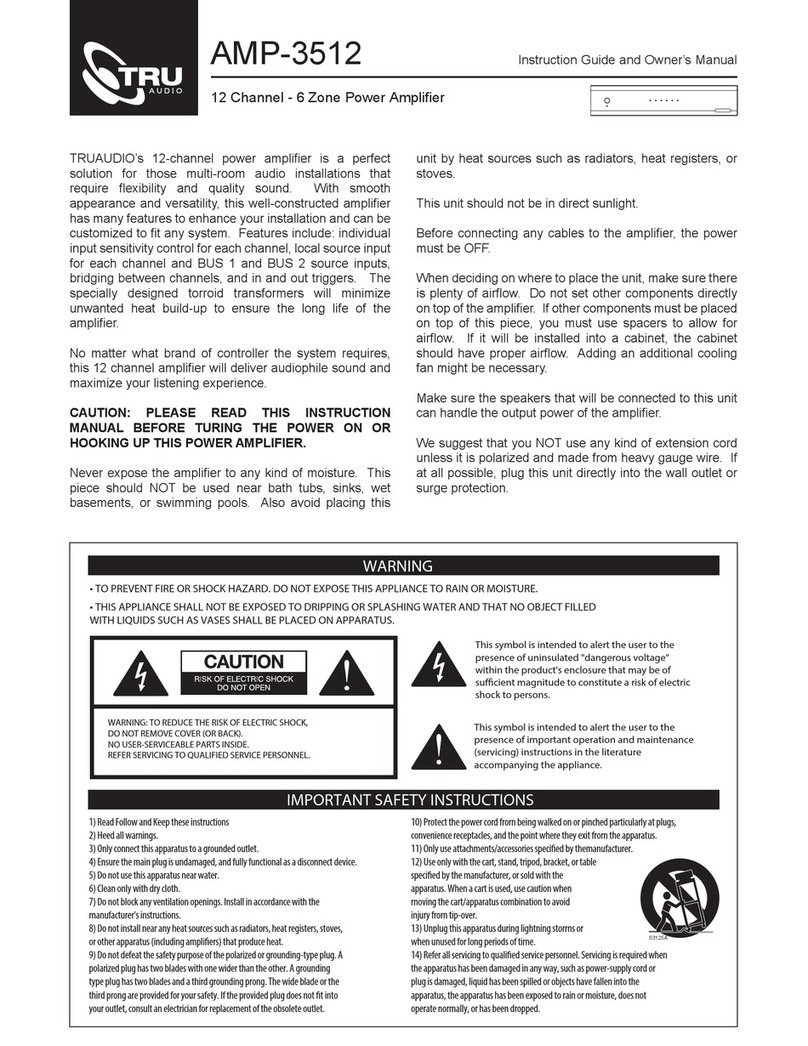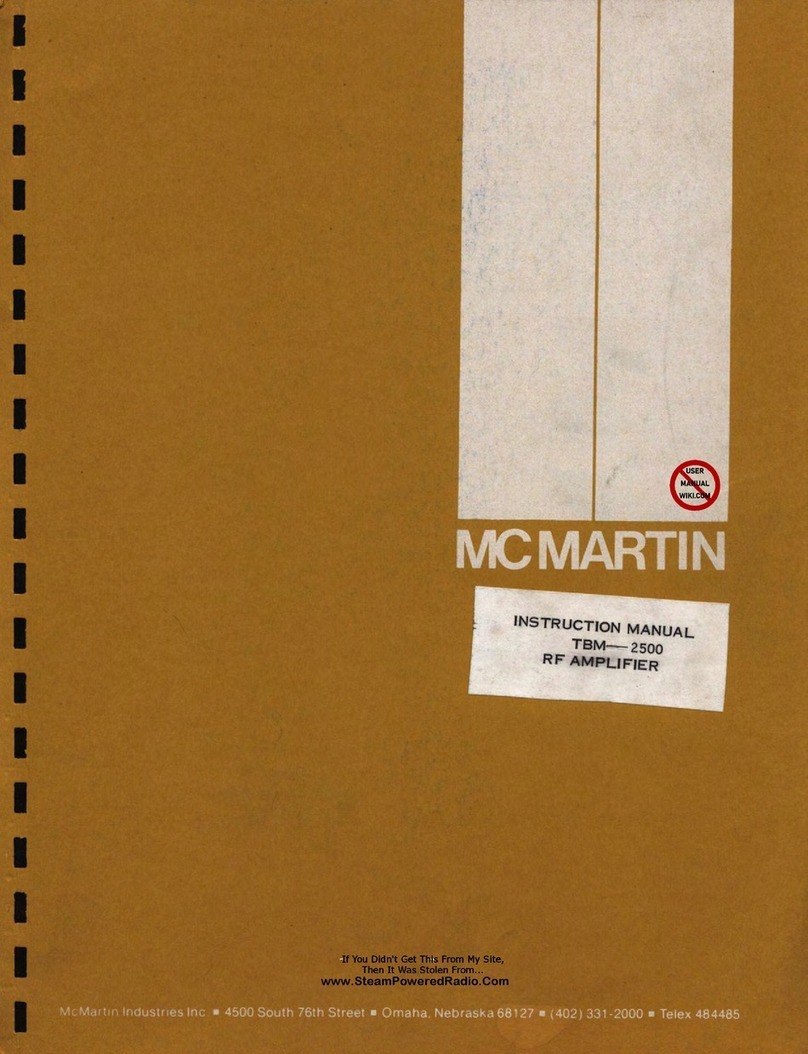DNA DNA-1350 User manual

1
David Nordschow Amplification
User Manual
For The
DNA-1350 Bass Amplifier
DNA-1350
©2014, David Nordschow Amplification LLC

2
Foreword
Thank you for purchasing a David Nordschow Amplification bass guitar amplifier. We
appreciate your faith in our ability to help to provide you with an outstanding Bass Guitar
Amplifier, and have worked hard to give you the very best products available today. We
design and build our amplifiers and electronics to give you outstanding performance and
years of trouble-free service. However, should you ever need service or replacement
parts for your equipment, we will do everything we can to assist you. To help us provide
service equal to our designs, please take the time to review this manual in its entirety
and to register online www.dnaamps.com. If you prefer, you may instead send in the
warranty registration card included in this manual.
As the market leader in High Performance Bass Amplification,we are proud of our
notable lineage and the many industry breakthroughs made by our founder David
Nordschow throughout his distinguished career. We design and engineer DNA
products to work in concert with each other to achieve a true synergy in their
performance. Our DNA series amplification systems feature, leading edge design,
outstanding performance quality and superior components, to ensure that our clients
receive the ultimate in tone, quality and long-term reliability, even under the most
rigorous touring conditions.
Please read this manual before operating your new equipment. Help us help you by
taking a few minutes to learn how to properly set up and use your new 1350 Bass
Guitar Amplifier. You’ll be glad you did!
CAUTION!
This product, when used in combination with amplification and/or
additional loudspeakers may be capable in certain situations of
producing sound levels that could cause possible hearing damage or
loss. DO NOT ever operate your products at high volume levels that
are uncomfortable or dangerous to yourself or others. Follow good
sound safety practices and use approved hearing protection if
needed. If you experience discomfort or ringing in the ears and/or
you suspect hearing loss, you should consult an audiologist
immediately.
Please take the time to review this manual and to register
your product with us online @ www.dnaamps.com

3
BASIC OPERATING INSTRUCTIONS
Your 1350 Amplifier has a smart switching supply that will automatically adjust to the
local operating voltage from 90 VAC to 250VAC and frequencies from 50-60 Hz. You
will need to have the correct type and style of AC power input cable connection for the
country you are playing in.
Connect your DNA Series bass guitar amplifier and appropriate speaker of a similar
power rating, using the NL-4 connectors on the rear of the amplifier chassis. The NL-4
connectors on both your amplifier and your DNA speaker cabinet are wired together in
parallel (see below) Connect your amplifier using one connector and use the other one
to connect another speaker cabinet if desired. Make certain that the total impedance of
all speaker cabinets you are using is no lower than the minimum rated impedance (4 Ω)
of your amplifier. Always make all speaker connections before turning your
amplifier on.
.
Connection Notes!
NEVER connect two different amplifiers together, or two channels of the same amplifier,
into one cabinet. This will be very likely to seriously damage your amplifier and possibly
the speaker cabinet as well.

4
IMPROTANT NOTE: DO NOT use a light gage shielded instrument type cable to
connect your amplifier and speaker together. This will cause very poor performance
and may even cause the amplifier to oscillate and distort. Always use a good quality,
heavy gauge speaker cable 16 gauge min. or preferably 12 - 14 gauge cables for the
best results.
Output connections:We use NL-4 type connectors. NL-2 type and NL-4 type
cables are both acceptable. Note that the +1/+2 pins are connected together as are -1/-
2 on both the NL4 connectors in your cabinet. This is to allow you to get the lowest
impedance possible in your cable connection for best bass response and peak power
delivery. We also provide a ¼” connector for temporary short term emergency use only.
The ¼ connector should not be used in place of the NL4 connections for normal
operation. The ¼” jack cable has a much lower current rating and will not perform as
reliably as the NL4 type connector.
Output power ratings: The 1350 can put out a full 1350 watts RMS into 4 Ω load.
It will put out the same amount of total power into a 2 Ωload. Even though it will
operate into that low an impedance load, we do not recommend a 2 Ωload for standard
configuration. The 1350 is designed to work most efficiently and effectively into a 4 Ωto
8 Ωload configuration.
Front Panel Controls and Features
Note: Level Controls go from what the incoming signal level is, down to off. Gain
Controls can amplify the incoming signal level to a much higher level.
Lower Control group
Main Signal Input Jack
The Main signal input is located on the left side of the front panel. It is a standard ¼
jack configured for monaural operation. The input impedance is 500K Ohms. Please
note: The rear input jack connection switches through the front input jack. They can
each be used separately but not together at the same time.
Mute To Tune
The Mute to Tune switch is green in the normal on or (out) position. When pressed in
(Mute is engaged) the switch will change color to red indicating the mute is engaged,
and the audio signal is no longer going to the output amplifier. The Tuning Jack on the
rear panel retains signal. The DI will not have signal present at its output when the
Mute is engaged.
Gain Control

5
The Gain Control is used to match the amplifier to your bass and playing technique.
Turn the Gain Control up to the point at which the green set level LED comes on and
flashes on the stronger notes. That will set your signal level to be in the sweet spot in
the gain chain. That will get you the best sound and lowest noise combination.
Shape Control
The Shape Control is a complex curve that boosts low end, scoops out the low
midrange and has a genteel rise toward the treble frequencies. It is very handy for
enhancing the tone curve for popping or slapping. It also works well in the studio for
giving you a quick way to change or shift to a different tone emphasis. Be careful not to
over use it in live playing conditions as the mid scoop can make it difficult to cut through
if you use too much of the effect.
Shape Bypass
The shape bypass is available only by foot switch control. It allows you to set up the
Shape Control for a specific tone character and then to bypass it. You can turn it on
and off with the footswitch when you need that special tone without having to adjust the
amplifiers controls each time. FT/SW (A) Jack. Switch (2).
4 Band Equalizer Set
The Four Band Tone Equalizer Set in the 1350 is highly musical and very simple to use.
The frequency centers are in the right places. The controls are fast and effective. All
four controls interact smoothly, seamlessly, and musically.
Bass Control
The Bass Control is set to increase or decrease the low bass frequencies. When the
control is set to center, it is inactive. When turned to the left, it goes negative, and to
the right it goes positive. It interacts smoothly with Low Midrange Control. This control
is centered around 35 Hz. This control is helpful for providing a deeper and more solid
bass tone when needed.
Low midrange Control
The Low Midrange Control is inactive at the center position. It controls the bass
frequencies from just above the low bass control range to the high midrange control.
This control is centered around 500 Hz. This control range is useful, adding a little extra
push or for scooping out the midrange area for getting that perfect tone balance while
playing jazz and other similar music types.
High Midrange Control
The High Midrange Control is inactive at the center position. It is set to interact
smoothly with the Low Midrange Control and covers the upper midrange frequencies. It
is centered at about 2K Hz. This range is useful for adding some cut to your sound for
playing pop and rock.
Treble Control

6
Treble Control goes from above the high midrange control out to the top of the normal
audio range. It's used to enhance brightness and sharpness in the overall tone settings.
Equalizer Bypass Switch
This is available only on the footswitch. FT/SW (A) Jack. Switch (1). This allows you to
set up a special tone setting on the 4 band tone controls and then bring it in and out as
needed by bypassing the tone setting back to straight wire flat.
Auxiliary Input Level Control
This controls the mix level of the Auxiliary inputs from the back panel. It has 6dB of gain
so you can properly mix your MP3 audio files, tunes, tracks or drum machine with your
bass at normal live playing levels.
Master Level Control
The Master Level Control is a level control, not a gain control. It is the final control
before the amplifier input. Use this control to set your overall sound level for the room
when you are playing.
Amplifier Standby Switch
This allows you to put the amplifier in the standby mode. This can be useful in the
studio and other places where you want to run the preamplifier but do not need the
amplifier to be operating.
Power On LED
The power on (green) LED turns on when unit is powered up and stays on as long as
unit is in normal operating condition. If the green power on LED is not on after you
power on the main switch. The unit has a problem and is not in proper operating
condition. If the green power on indicator will not illuminate, the unit has an operational
problem and needs to be checked out by your dealer or authorized DNA service center.
Peak Level LED
The amber colored Peak Level LED flashes briefly when your unit’soutput amplifier
exceeds 0.01% total harmonic distortion. This function is basically a peak output
indicator, though it comes on at well below the actual peak output of the amplifier.
System Protect LED
Under normal circumstances, you should only see the red system protect LED come on
when you're turning on or turning off your unit. It should extinguish after the start cycle
or stop cycle is completed. If it remains on them there is a problem with the operating
system or with the operating conditions of your amplifier that you will have to check.
Typically, you would check the AC power condition and both the input and output cables
to make sure everything is in good working order. Then turn off and restart the
amplifier. That should normally resolve the problem. If the problem persists even with
the inputs and outputs unplugged, and the protect LED remains lit. It is likely your unit
has a board level electronic fault in needs to be serviced by a DNA dealer or service

7
center. If all three lights are flashing together this is also a system fault indicator and
unit requires servicing to resolve the problem.
Upper Control Group
Input Pad
Use this control switch to reduce the signal level of your bass if it is coming into your
unit at too high a level to match up correctly with the input gain control. When this is
engaged the Pad switch will change color from green to yellow
DI Level send
The Front panel DI Level Send allows you to control the level of the DI signal going to
the mixing or recording console. This control allows you to adjust from microphone
level to low line level.
DI Pre/Post Switch
The Pre/Post DI switch allows you to select either pre-tone or post tone single
configuration to send to the DI output. This feature is only available from the front
panel. When this is engaged to post, the switch will change from green to yellow
Compressor Threshold Control
The Threshold Control sets the level at which the compressor begins to compress. This
is also called the knee of the compressor. Turning the control to the right will allow the
compressor to engage sooner. Turning the control more to the left it will let the
compressor engage at a higher signal level or not at all.
Compressor Raito Control
The Compressor Ratio Control allows you to select the way the signal is compressed.
When the control is set to the left side near zero, it will compress very gently, at a low
compression ratio. As the control is turned to the right, the ratio will become higher until
it becomes a hard limiter at the control’s far right position.
Compressor bypass Switch
The Compressor Bypass Switch allows you to preset the compressor to the desired
level or effect in playing situations, and then to bypass the compressor, when you no
longer want to use the compression effect. You can use both the panel control and the
foot switch to engage the Compressor Bypass Switch. When this is engaged the switch
will change from green to yellow. Note: The comp. Led will continue to blink while
playing even when it is in the bypass mode. FT/SW (B) Jack. Switch (2).
Effects On/Off Switch

8
The Effects On/Off Switch is used to turn on and turn off the effects loop. This feature
is available both from the panel face and from the foot switch. When this is engaged
the switch will change from green to yellow. FT/SW (B) Jack. Switch (1).
Back Panel Controls and Features
AC Input
The AC Input cable is connected to a standard IEC type input. The power supply will
automatically adjust from 90 VAC to 150 VAC, and works with 50 or 60 Hz.
Mains Power switch
The Mains Power Switch is located above the AC inlet. It is an illuminated red type
switch. Pressing the ( | )symbol at the top of the switch turns your unit on.
Fuses
There are no user serviceable fuses inside the unit. Your 1350 amplifier contains a 10A
fuse which is part of the power supply module. It is not user serviceable. In the event
of a clear fuse failure or a total lack of amplifier power up of the please contact your
dealer or service center for assistance.
Fan
The low noise DC cooling fan in the 1350 is set to run continuously at a very low speed
in order to make it as quiet as possible for recording and live playing situations.
Amplifier Output Jacks
The Amplifier Output Jacks available on 1350 are configured as two NL4 type jacks
(main), and one 1/4 inch phone jack for (emergency use).
Use the NL4 jacks for normal operation. The main speaker jacks are wired +1 and +2
together and -1 and -2 together. The unit will accept both the NL2 or NL4 type cable
connections. The configuration is designed to give you the best connection possible
your speaker cabinet. This will give you the best quality sound, power output, and the
deliver maximum available current to the loudspeakers.
DI Output XLR Jack
The DI Output Jack is a balance line XLR type configured with pin (2) hot or plus. The
signal is very low noise and is studio quality. The output is protected to handle phantom
power voltages if they are accidently applied to the DI output. It is recommended that
you turn off phantom voltage to this jack before using the unit. The specialized THAT
chip that drives this output is configured as an electronic transformer and is fully
balanced.
Ground lift

9
The ground the switch is located next to the DI output XLR. It allows you to reconfigure
the ground reference for pin one of the XLR. In the normal condition pin one of the
output jack is connected directly to the main chassis ground. When the ground is lifted
by engaging the ground lift switch, a small resistor is placed in series with the ground
connection. This is useful for eliminating or reducing ground loops and unwanted hum
and noise in the systems.
Auxiliary Input jacks
The AUX IN as an RCA input Jack set that features actively summed left and right
inputs. It has six dB of voltage gain. It provides a high-quality input that can take an
IPad, auxiliary device or drum machine and amplify it to the proper level to mix with the
live bass guitar signal.
Foot switch control jack A
Switch connection Jack (A). Switch one and two control the tone equalizer bypass and
the shape bypass functions. These features are only available on the foot switch.
EQ. Bypass FT/SW (A) Switch (1). Shape Bypass FT/SW (A). Switch (2).
Foot switch control jack B
Switch connection Jack (B) switch one and two allow you to control both the effects
on/off, and the compressor bypass function from this foot switch. Both the FX on off in
the compressor bypass are available both from the front panel and the foot switch.
FX On/Off FT/SW (B) Switch (1) Comp Bypass FT/SW (B) Switch (2)
Slave Output Connection
The slave output connection is used to link other amplifiers to your amplifier, making
your amplifier final volume control the master control for the system.
Slave Input Connection
This input jack allows you to connect your unit’s amplifier as a powered slave to another
preamplifier. This connection bypasses the main input jack, preamp and all controls on
your unit.
Side Chain Loop
The side chain effects loop is a useful feature that allows you to connect a special effect
in parallel with your normal tone controls. This lets you blend the effects signal with the
normal signal. You thereby maintain the best possible signal-to-noise ratio and overall
sound quality possible while using a special effect.
Effects Loop

10
The main effects are a standard serial effects loop. The return jack set breaks the signal
chain and results in 100% of the signal going through the effects loop before coming
back to the rest of the signal chain. The send can also be used as an extra signal output
if the return jack is not used.
Tuner Output
This Jack provides a slightly amplified and buffered signal that can be connected to the
tuner input of your choice.
Rack Access Rear Input Jack
This Jack provides an alternative input access for plugging in things like wireless
receivers or any input that needs to be connected from inside the rack or to the back of
the unit. When you operate the rear panel input jack you cannot operate the front panel
input jack. They are configured to be either or.
Operations
Turning on your amplifier
Before turning on your amplifier please make sure you read the manual and understand
it. Make the connections your loudspeaker before powering on the amplifier. Switch on
amplifier by pressing the mains power switch ( | ) emblem on the top of the switch. All
the amplifier management lights on the front panel will come on momentarily. Then the
red and yellow lights will turn off leaving only the green light glowing steadily. This is the
normal condition and indicates your amplifier is in good condition and ready to operate.
Turning off the amplifier
Press the ( 0 ) emblem on the mains power switch to turn off the unit. It is located on the
back panel. All the lights on the amplifier management group will light up momentarily
but after few seconds they will all go off.
What to expect if your amplifier goes into the protect mode
Your 1350 amplifier has a very sophisticated 1 cycle monitoring system for the power
supply and amplifier. If the system detects a short circuit or a dangerous condition such
as, over temperature, excessive amounts of clipping, excessive current usage, or
improper power configuration conditions the amplifier may go into the protect mode for
safety.
The Red Protect light will come on to alert you that the unit is in the protect mode.
Determine what is causing the unit to go into protect mode. After you resolve that
problem, you will need to shut off and then restart your amplifier. Whenever the
amplifier goes into the protection mode it will be necessary to shutdown and then restart
the amplifier to clear the safety function lockout and restore the unit to normal operating
conditions. A damaged speaker cable, intermittent AC connections, excessively high

11
temperatures and unusually high current demands that exceed the systems normal
parameters can potentially cause the system to go into protect mode.
Output Peak Indicator
The output limit indicator is the yellow LED. It will flash briefly anytime the amplifier
output distortion exceeds 0.01%. This normally occurs as the amplifier nears full power.
This light flashing is an indication that you are getting close to the full power limits of the
amplifier. It is not aclipping indicator. It is okay for the light to be flashing periodically,
but it should not be on continuously.
3 Year Warranty Terms
DNA LIMITED WARRANTY
DNA LLC warrants the product you have purchased to be free of defects in materials
and workmanship in normal use for a period of (3) years from the date of original
purchase. This warranty shall be to the original purchaser when purchased from an
Authorized DNA Dealer. The manufacturer warrants the speakers for period of (3)
years. Defective parts found during the warranty period will be replaced or repaired
without charge with a proof of purchase if the complete product is returned to DNA LLC
or any Authorized DNA Service Center within the U.S.A.
DNA LLC reserves the right to use materials readily available at the time of the repair.
All Warranty service requires a Proof of Purchase (sales receipt) to be presented at time
of service request. Any repair or service performed by any person or entity other than
the DNA factory, or an Authorized DNA Service Center is not covered by this limited
warranty. The customer is responsible to pay transportation to and from The DNA LLC
Authorized Service Center, if the required service cannot be performed at the
Authorized DNA Service Center the unit must be returned the DNA factory for that
service.
What is covered against manufacturing defects
Parts and Labor to correct any defect in original materials and or workmanship.
WHAT IS NOT COVERED
Products whose serial numbers have been altered or removed or have had their RFID
chips removed. Normal wear and tear from use is not covered. Damage to the units
finish due to misuse. Operations that are outside of the specified ratings, neglect or
accident.
Shipping Damage is not covered under the warranty. Report damage upon receipt of
item to the carrier (i.e. UPS). The freight carrier must be notified upon receipt of items to
insure a freight damage claim resolution. Shipping damage not filed with carriers within
(48) hrs upon receipt will not be covered under warranty. Report any shipping damage

12
within (48) hrs of receipt to your DNA Dealer. Keep all original documents and packing
materials to insure freight damage claim resolution. Any merchandise that has been
altered, or modified from its original OEM condition. DNA LLC is not responsible for any
items left in protective covers or cases, (We strongly advise that all personal items such
as chords, cables, tuners, etc. be removed!) freight charges to and from the factory or
an Authorized service center on customer owned goods, any and all charges incurred
from priority service requests (Rush Service) or priority shipping for replacement parts.
Any and all charges if no problem is found.
Factory Service Terms
Return Authorization
All items being returned for any reason must have a Return Merchandise Authorization
number. This RMA # must be placed on the outside of the carton of the item being
returned or the carton will be refused upon delivery. Please contact your local dealer for
a return merchandise authorization number in the event your equipment is in need of
factory service. Dealer stock items than cannot be repaired on site will be returned to
the dealer freight prepaid.
Field Service Terms
An Authorized DNA Warranty Service Center must perform any and all field warranty
service work. Customer will not pay for parts and/or labor provided the problem found is
within warranty guidelines. Proof of purchase must be provided at the time of service
request. Transportation charges to and from the Authorized Warranty Service Center
are the responsibility of the customer. Rush service charges and special freight charges
for required parts are not covered under warranty and are also the responsibility of the
customer. If a unit is not easily transported to an authorized service center, the
customer is responsible for technician travel charges. Any charges for labor or
processing when no problem is found are also not covered under warranty. Any charges
incurred for work performed by an unauthorized service center are the responsibility of
the customer.
DNA LLC
www.dnaamps.com.
Table of contents
Popular Amplifier manuals by other brands
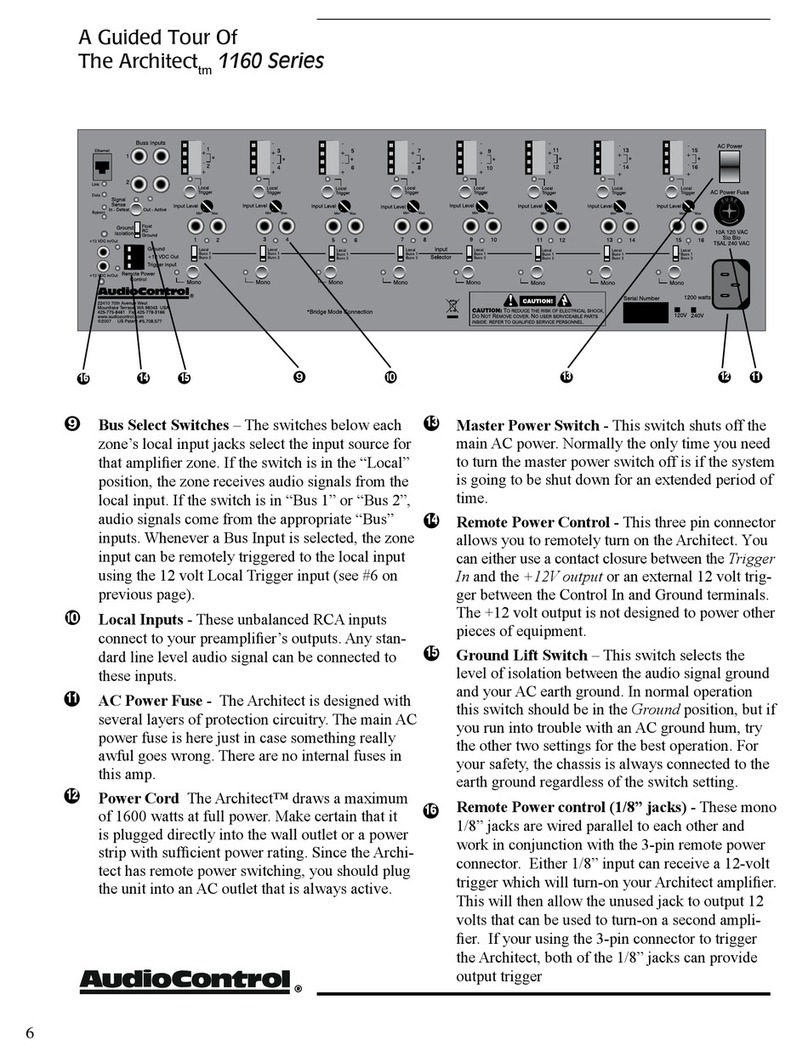
Audio Control
Audio Control Architect 1160 Installer's guide
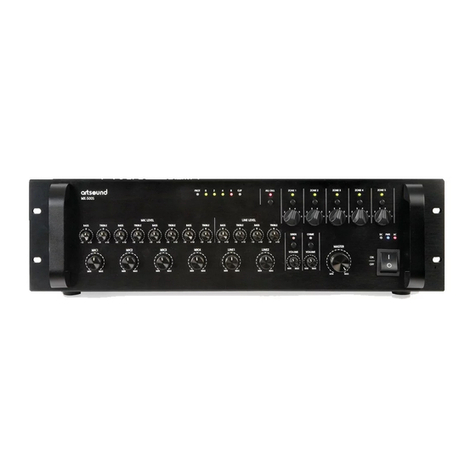
ART+SOUND
ART+SOUND MX-500S operating manual

A-Neuvideo
A-Neuvideo ANI-PA instruction manual
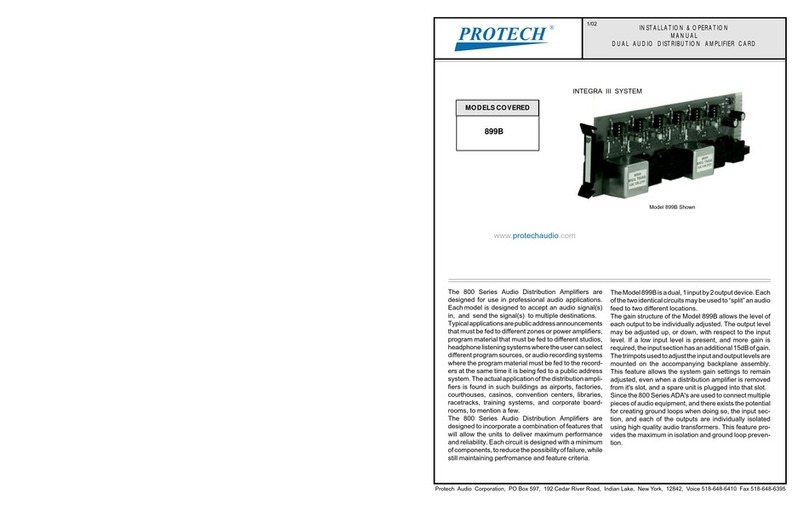
protech
protech INTEGRA III 899B Installation & operation manual
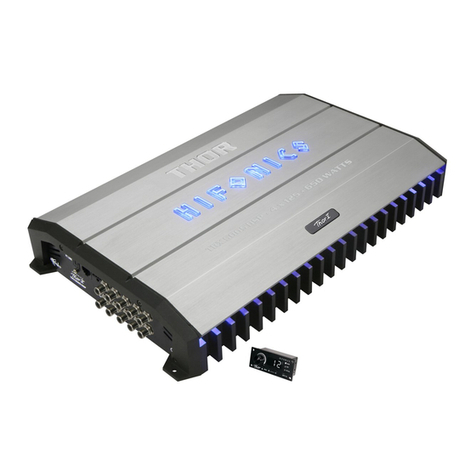
Audiodesign
Audiodesign Hifonics Thor Series owner's manual
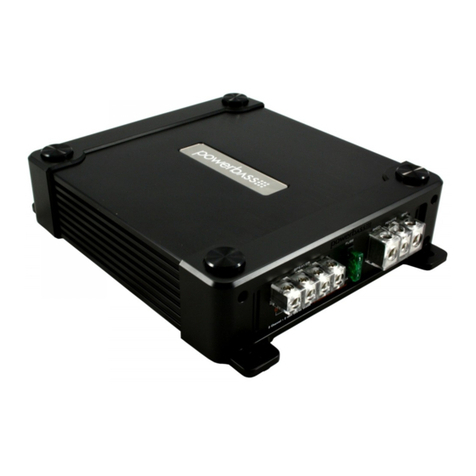
Power bass
Power bass ATM 330.2 owner's manual
